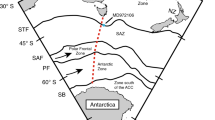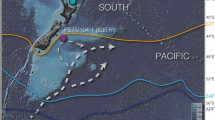Abstract
The nitrogen-isotope record preserved in Southern Ocean sediments, along with several geochemical tracers for the settling fluxes of biogenic matter, reveals patterns of past nutrient supply to phytoplankton and surface-water stratification in this oceanic region. Areal averaging of these spatial patterns indicates that reduction of the CO2 ‘leak’ from ocean to atmosphere by increased surface-water stratification south of the Polar Front made a greater contribution to the lowering of atmospheric CO2 concentration during the Last Glacial Maximum than did the increased export of organic carbon from surface to deep waters occurring further north.
This is a preview of subscription content, access via your institution
Access options
Subscribe to this journal
Receive 51 print issues and online access
$199.00 per year
only $3.90 per issue
Buy this article
- Purchase on Springer Link
- Instant access to full article PDF
Prices may be subject to local taxes which are calculated during checkout





Similar content being viewed by others
References
Sarmiento, J. L. & Toggweiler, R. Anew model for the role of the oceans in determining atmospheric p CO 2 Nature 308, 621–624 (1984).
Siegenthaler, U. & Wenk, T. Rapid atmospheric CO2variations and ocean circulation. Nature 308, 624–626 (1984).
Knox, F. & McElroy, M. B. Changes in atmospheric CO2: Influence of the marine biota at high latitude. J. Geophys. Res. 89, 4629–4637 (1984).
Toggweiler, R. & Sarmiento, J. L. in The Carbon Cycle and Atmospheric CO2: Natural Variations Archean to Present (eds Sundquist, E. T. & Broecker, W. S.) 163–184 (Vol. 32, Geophys. Monogr. Ser., Am. Geophys. Union, Washington DC, (1985)).
Wenk, T. & Siegenthaler, U. in The Carbon Cycle and Atmospheric CO2: Natural Variations Archean to Present (eds Sundquist, E. T. & Broecker, W. S.) 185–194 (Vol. 32, Geophys. Monogr. Ser., Am. Geophys. Union, Washington DC, (1985)).
Knox-Ennever, F. & McElroy, M. B. in The Carbon Cycle and Atmospheric CO2: Natural Variations Archean to Present (eds Sundquist, E. T. & Broecker, W. S.) 154–162 (Vol. 32, Geophys. Monogr. Ser., Am. Geophys. Union, Washington DC, (1985)).
Kumar, N. et al. Increased biological productivity and export production in the glacial southern ocean. Nature 378, 675–680 (1995).
Altabet, M. A. et al. Seasonal and depth-related changes in the source of sinking particles in the North Atlantic detected using 15N/14N ratios. Nature 354, 136–139 (1991).
Francois, R., Altabet, M. A. & Burckle, L. D. Glacial to interglacial changes in surface nitrate utilization in the Indian sector of the southern ocean as recorded by sediment δ15N. Paleoceanography 7, 589–606 (1992).
Altabet, M. A. & Francois, R. Sedimentary nitrogen isotopic ratio as a recorder for surface ocean nitrate utilization. Glob. Biogeochem. Cycles 8, 103–116 (1994).
Altabet, M. A. & Francois, R. in Carbon Cycling in the Glacial Ocean: Constraints on the Ocean's Role in Global Change (eds Zahn, R., Pedersen, T. F., Kaminski, M. & Labeyrie, L. D.) 281–306 (Vol. 17, NATO AST Ser. I, Springer, Berlin, (1994)).
Mortlock, R. A. et al. Evidence for lower productivity in the Antarctic Ocean during the last glaciation. Nature 351, 220–223 (1991).
Charles, C. D. et al. Biogenic opal in southern ocean sediments over the last 450,000 years: Implications for surface water chemistry and circulation. Paleoceanography 6, 697–728 (1991).
Bareille, G. et al. Biogenic silica accumulation rate during the Holocene in the southeastern Indian Ocean. Mar. Chem. 35, 537–551 (1991).
Suman, D. O. & Bacon, M. P. Variations in Holocene sedimentation in the North American basin determined from 230Th measurements. Deep-Sea Res. 36, 869–878 (1989).
Francois, R., Bacon, M. P. & Suman, D. O. Thorium-230 profiling in deep-sea sediments: High-resolution records of flux and dissolution of carbonate in the equatorial Atlantic during the last 24,000 years. Paleoceanography 5, 761–787 (1990).
Kumar, N. et al. 231Pa/230Th ratios in sediments as a proxy for the past changes in southern ocean productivity. Nature 362, 45–48 (1993).
van Bennekom, A. J. et al. Primary productivity and the silica cycle in the southern ocean (Atlantic sector). Palaeogeogr. Palaeoclimatol. Palaeoecol. 67, 19–30 (1988).
Frank, M. Reconstruction of late Quaternary environmental conditions applying the natural radionuclides 230Th, 10Be, 231Pa and 238U: A study of deep-sea sediments from the eastern sector of the Antarctic Circumpolar Current system.Thesis, Heidelberg Univ.((1995)).
Burckle, L. H. Diatom distribution and paleoceanographic reconstruction in the southern ocean: Implications for late Quaternary paleoceanography. Mar. Micropaleontol. 9, 241–261 (1984).
Morley, J. J. Variations in high-latitude oceanographic fronts in the southern Indian Ocean: An estimation based on faunal changes. Paleoceanography 4, 547–554 (1989).
Sullivan, C. W. et al. Distribution of phytoplankton blooms in the southern ocean. Science 262, 1832–1837 (1993).
Bacon, M. P. Tracers of chemical scavenging in the ocean: boundary effects and large scale chemical fractionation. Phil. Trans. R. Soc. Lond. A 320, 187–200 (1988).
Anderson, R. F. et al. Boundary scavenging in the Pacific Ocean: a comparison of 10Be and 231Pa. Earth Planet. Sci. Lett. 96, 287–304 (1990).
Yu, E.-F. Variations in the particulate flux of 230Th and 231Pa and paleoceanographic applications of the 231Pa/230Th ratio.Thesis, WHOI-MIT((1994)).
Walter, H.-J., Rutgers van der Loeff, M. M. & Hoeltzen, H. Enhanced scavenging of 231Pa relative to 230Th in the south Atlantic south of the Polar Front: Implications for the use of the 231Pa/230Th ratio as a paleoproductivity proxy. Earth Planet. Sci. Lett. 149, 85–100 (1997).
Yu, E.-F., Francois, R. & Bacon, M. P. Similar rates of modern and last-glacial ocean thermohaline circulation inferred from radiochemical data. Nature 379, 689–694 (1996).
Klinkhammer, G. & Palmer, M. R. Uranium in the oceans, where it goes and why. Geochim. Cosmochim. Acta 55, 1799–1806 (1991).
Bareille, G. et al. Glacial-Interglacial changes in the accumulation rates of major biogenic components in southern Indian Ocean sediments. J. Mar. Syst. (in the press).
Dymond, J., Suess, E. & Lyle, M. Barium in deep-sea sediment: A geochemical indicator of paleoproductivity. Paleoceanography 7, 163–181 (1992).
Francois, R. et al. Biogenic Ba fluxes to the deep-sea: Implications for the paleoproductivity reconstruction. Glob. Biogeochem. Cycles 9, 289–303 (1995).
Nurnberg, C. C. Bariumfluss und sedimentation im sudlichen Sudatlantik-Hinweise auf produktivitatsanderungen im Quartar.Thesis, Kiel Univ.((1995)).
Sigman, D. M. et al. in ASLO, Aquatic Sci. Meeting Abstr.Santa Fe, New Mexico, 304 ((1997)).
Sigman, D. M. The role of biological production in Pleistocene atmospheric carbon dioxide variations and the nitrogen isotope dynamics of the Southern Ocean.Thesis, WHOI-MIT((1997)).
GEOSECS Sections and Profiles (National Science Foundation, WashingtonD, (1982)).
Sigman, D. M. et al. Diatom microfossil nitrogen isotopic composition supports the hypothesis of higher nitrate utilization in the glacial southern ocean. Eos 78, S190 (1997).
Shemesh, A. et al. Isotopic evidence for reduced productivity in the glacial southern ocean. Science 262, 407–410 (1993).
Morley, J. J. & Hays, J. D. Oceanographic conditions associated with the high abundance of radiolarian Cyclodophora davisiana. Earth Planet. Sci. Lett. 66, 63–72 (1983).
Yang, J. & Honjo, S. J. Modeling the near-freezing dichothermal layer in the sea of Okhotsk and its interannual variations. J. Geophys. Res. 101, 16421–16433 (1996).
Kohfeld, K. E., Fairbanks, R. G., Smith, S. L., Walsh, I. D. Neogloboquadrina pachyderma (sinistral coiling) as paleoceanographic tracers in polar oceans: Evidence from Northeast Water Polynya plankton tows, sediment traps and surface sediments. Paleoceanography 11, 679–700 (1996).
Charles, C. D. & Fairbanks, R. G. in Geological History of the Polar Oceans: Arctic versus Antarctic (eds Bleil, U. & Thiede, J.) 519–538 (Kluwer Academic, Norwell, MA, (1990)).
Sigman, D. & McCorkle, D. Comparing the closed and open system effects of changes in low latitude biological production using a reservoir model of the ocean carbon cycle. Eos 75, 367 (1994).
Keir, R. S. On the late Pleistocene ocean geochemistry and circulation. Paleoceanography 3, 413–445 (1988).
Lynch-Stieglitz, J., van Geen, A. & Fairbanks, R. G. Interocean exchange of Glacial North Atlantic Intermediate Water: Evidence from Subantarctic Cd/Ca and carbon isotope measurements. Paleoceanography 11, 191–202 (1996).
Michel, E. et al. Could deep Subantarctic convection feed the world deep basins during the last glacial maximum? Paleoceanography 10, 927–942 (1995).
Kellogg, T. B. Glacial-Interglacial changes in global deepwater circulation. Paleoceanography 2, 259–271 (1987).
McCorkle, D. C. et al. Evidence of a dissolution effect on benthic foraminiferal shell chemistry: δ13C, Cd/Ca, Ba/Ca, and Sr/Ca results from the Ontong Java Plateau. Paleoceanography 10, 699–714 (1995).
Howard, W. R. & Prell, W. L. Late Quaternary CaCO3production and preservation in the Southern Ocean: Implications for oceanic and atmospheric carbon cycling. Paleoceanography 9, 453–482 (1994).
Bareille, G. Flux sedimentaires: paléproductivité et paléocirculation de l'Océan Austral au cours des 150,000 dernières années.Thesis, Univ. Bordeaux((1994)).
Author information
Authors and Affiliations
Corresponding author
Rights and permissions
About this article
Cite this article
François, R., Altabet, M., Yu, EF. et al. Contribution of Southern Ocean surface-water stratification to low atmospheric CO2 concentrations during the last glacial period. Nature 389, 929–935 (1997). https://doi.org/10.1038/40073
Received:
Accepted:
Issue Date:
DOI: https://doi.org/10.1038/40073
This article is cited by
-
The southward migration of the Antarctic Circumpolar Current enhanced oceanic degassing of carbon dioxide during the last two deglaciations
Communications Earth & Environment (2024)
-
Indian Ocean glacial deoxygenation and respired carbon accumulation during mid-late Quaternary ice ages
Nature Communications (2023)
-
Southern Ocean glacial conditions and their influence on deglacial events
Nature Reviews Earth & Environment (2023)
-
Rapid increase of surface water pCO2 revealed by settling particulate organic matter carbon isotope time series during 2001–2009 in Sagami Bay, Japan
Journal of Oceanography (2023)
-
Enhanced ocean oxygenation during Cenozoic warm periods
Nature (2022)
Comments
By submitting a comment you agree to abide by our Terms and Community Guidelines. If you find something abusive or that does not comply with our terms or guidelines please flag it as inappropriate.



